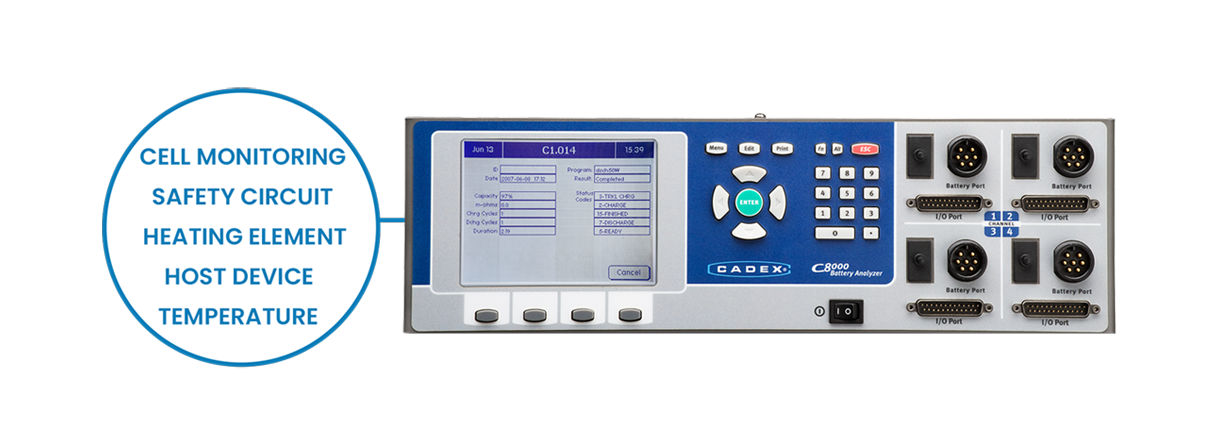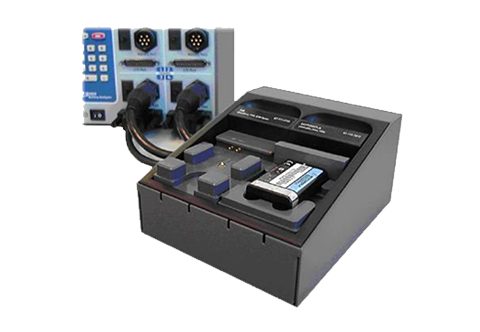Smart Battery Test
The Cadex C8000 reads SMBus batteries to verify fuel gauge settings, provide calibration, do performance check and assist in troubleshooting.
Runtime Test
The Cadex C8000 allows testing batteries under GSM, CDMA and other digital protocols. Programming is in 50µs intervals with minimum setting of 500µs.
Application: Dynamic stress tests to examine battery runtime under digital load conditions.

Lifecycle Test
The Cadex C8000 tests batteries by continuously cycling to end-of-life. PC-BatteryLab™ records the test results in real time.
Application: Life-test until the capacity drops to the Target Selector red-line.


Core Features
Independent I/O Ports
Each channel features a Battery Port and I/O Port for individual programming with:
- Positive/negative input; 4-wire Kelvin
- 1 analog thermistor input
- 4 differential analog voltage inputs
- 2 analog outputs
- 4 input/output control for switching
- SMBus, clock, data for smart packs

Serving as a laboratory command center
Serving as Laboratory System
Transform your C8000 into an automated command center running external accessories:
- Cell monitoring
- Heating element
- Pressure gauge
- Safety circuit
- Alarms (with custom programs using PC-BatteryLab)

External Load Bank
One of the four channels supports the load bank. For safety, reasons, load bank service is limited to discharge only.

Dual Power Port Cable (DPPC)
The DPPC allows parallel connection of channels 1 and 2, or 3 and 4, to increase current from 10A to 20A.
Limitation: DPPC only applies to discharge.

Cell Monitoring
Floating analog inputs enable voltage check of up to 5 cells
Advanced Programs
Load Test |
Tests batteries under simulated GSM, CDMA and other discharge protocols, 50μs steps; minimum setting 500μs. |
Runtime |
Provides three discharge levels; programmable in hours and minutes. |
Lifecycle |
Cycles battery until the capacity fades the set Target Selector threshold. |
Self-Discharge |
Determines the rate at which a battery loses charge. Assure intrinsic safety. |
Discharge Only |
Prepares battery for shipping and storage. Also checks charger function. |
Load Capture |
Simulates real life conditions with pre-recorded load. Requires PC-BatteryLab™ and Load Capture Unit to record load signature. |
OhmTest™ |
Measure battery resistance with DC pulses in 13 seconds; based on IEC61436. |
Impedance |
Measures battery resistance with 1000Hz signal. Channel 1 only. |
Basic Programs
Charge |
Applies fast charge with charge termination; trickle when applicable. |
Auto |
Charge-discharge-charge; applies Recondition on nickel-based batteries if user-set target capacity cannot be reached. |
Prime |
Prepares batteries by cycling until the maximum capacity is reached. The first reading is the spare capacity before charge. |
Extended Prime |
16-hour trickle charge prior to Prime. Assist in formatting battery. |
Boost |
Activates batteries that have been discharged too low. |
Custom Programs
Provide user-defined settings of charge, discharge, recondition, wait and repeat. You can set conditional gates that proceed on a different course if certain criteria are not met.
Complete and Affordable
The Cadex C8000 stands in a class by itself in price and flexibility. Digital technology offers advantages over analog systems in providing large test ranges with high stability. Each of the four channels can be programmed up to 10A and 36V (nominal) with combined power of 400W.
The Cadex C8000 features redundant safety algorithms; however, the system can be overridden for destructive tests. The Cadex C8000 is intuitive and requires little training.
Options
PC-BatteryLab™ Software
- Networks up to eight C8000 for simultaneous service of 32 batteries.
- Enables custom program and load capture.
- Real time observation of current, voltage and temperature.
Note: PC-BatteryLab™ is compatible with Windows XP, Windows 7, Windows 8, and Windows 10. Not compatible with Windows Vista.

Real-time graphs plotting current, voltage temperature
Accessories

Load Capture
The C8000 performs simulated discharge tests to verify battery runtimes in field conditions with recorded load patterns. Recording time is 5 minutes with repeat loops for continued service.
Note: External load bank enables pulses of up to 100A.

LOAD CAPTURE UNIT (LCU)
The LCU captures load profiles for simulation with currents of up to 100A. The I/O Ports and Type K thermo-coupler are brought to the front for easy access.

Adapter Unit
The Adapter Unit provides interface to SnapLock™ Battery Adapters (as used on C7x00). Adapter Unit features two bays.
C8000 Battery Testing System |
|
|---|---|
| Application |
Digital battery testing system that includes:
|
| Independent channels | 4 separate Battery Ports and I/O Ports. |
|
Battery voltage range 1.2V–36V nominal (max 45V) |
|
| Charge/discharge current | 30mA–10A, settable in 1mA increments. 20A discharge with Dual Power Port Cable |
| Maximum charge power | Continuous dissipation of 100W per station; 400W in total. |
| Maximum discharge power |
Continuous dissipation 80W per station; 320W in total. Dual Power Port Cable doubles discharge current to 20A and 160W Optional load bank increases power up to 2400W at 48V |
| Power Management | Fully loaded, batteries go on waiting queue. Will resume when demand moderates. Ah values entered above the analyzer’s current limit are automatically lowered to workable values with C-rate adjustments. |
| Charge Methods |
Li-ion: Constant voltage with current limit and saturation charge, no trickle charge when full. Also services LiFePO. Lead Acid: Constant voltage with current limit and saturation charge. Float charge when full. Nickel-based: Constant current with negative slope or plateau timer to terminate charge. Applies a 0.05C trickle charge. |
| Discharge Methods |
|
| Target Selector |
Serves as gatekeeper User-selectable from 50% to 100%. Batteries that meet performance meeting expectation get a green light, low capacity get an amber, and anomalies get a red light. |
| Basic Programs |
Charge: Applies fast charge with full-charge termination. Auto: Charge-discharge-charge; applies Recondition on nickel-based batteries if user-set target capacity cannot be met. Prime:Prepares batteries by cycling until the maximum capacity is reached. The first reading is the spare capacity before charge. Extended Prime: 16h trickle charge prior to Prime. Assists in formatting batteries Boost: Activates batteries that became deactivated due to low discharge. |
| Advanced Programs |
Load Test: Tests batteries under discharge protocols, 50μs steps; minimum setting 500μs. Runtime: Provides 3 discharge levels, programmable in hours and minutes. Lifecycle: Cycles battery until capacity fades to Target Selector threshold. Self-Discharge: Measures self-discharge of batteries to assure safety. Discharge Only: Prepares battery for shipping and storage while measuring the battery capacity. Load Capture: Discharges battery on recorded load signature. (Requires Load Capture Unit). SMBus: Checks fuel gauge settings, provides calibration, and verifies performance to support design. |
| Rapid Test Programs |
OhmTest™: Tests battery resistance with DC pulses (IEC61436 standard). Impedance: Checks battery resistance with 1000Hz signal. (Channel 1 only) Note: A reactive part gives different readings with DC and AC test methods. |
| Custom Programs |
Allows 100 user-defined programs of charge, discharge, waits, repeats, etc. Note: Supervision recommended when overriding safety redundancies. |
| Security | Password protection prevents unauthorized access. |
| Display | 320x240 graphics display with backlight (5.7” diagonal) QVGA resolution |
| Power failure recovery | Retains test data; resumes when power is restored. Time of power failure is recorded |
| Accuracy | +/-0.1% on voltage; +/-0.25% on current; full scale. |
| Sample rate | Up to 500μs, display updated every 1 second; data logging 1–60 seconds. |
| Response time | 50–100μs depending on voltage and current |
| Data Capture Rate | 2–200 microseconds (last 500 samples) |
| Load Capture | Minimum sample rate 500 microseconds; number of samples 10–500 |
|
Battery Ports Circular; front-mounted |
Battery Positive (+), Battery Negative (–), Sense Positive (+), Sense Negative (–), Thermistor Input, Thermistor Ground |
|
I/O Port DB25, front mounted |
4 user-selectable analog input ranges: 0-5V, 0–10V, 0–15V; 12-bit resolution, floating ground, 0–50V common mode range.; 2 analog outputs, 0–5V (+/-1mA); 4 digital, 5V TTL levels with open-drain output and 20mA (max) sinking ability. 2 general purpose analog inputs, 0–3.3V. SMBus, clock, data and ground. Each port is protected by a resettable fuse. |
|
Data Ports Mounted on the back |
RS-232; Ethernet 10/100 for PC connection, control of external load bank and environmental chamber with F4 module. |
| Data Acquisition | System Sample Rate: 500ms; Terminal Data (last 500 samples) Capture Rate: 2-200ms; Capture/Display Rate (non-termination): 1-60s; Load Capture: Min Sample Rate Increment 500ms; # of Samples = 10-500 |
|
Dimensions Weight |
W: 430mm (17”); D: 430mm (17”); H: 130mm (5.1”); 3U standard; Weight 12.6kg (27.7 lb) net; 15.5kg (34 lb.) shipping |
| Environmental |
Recommended operating temperature 5 °C to 35 °C (41°F to 95 °F) Recommended storage temperatures –20 °C to 70 °C (–4°F to 159°F) |
| Firmware | Upgradeable with PC-BatteryLab™ (Included with system). |
| Approvals | CSA 22.2 No: 61010-1, UL 61010-1 and EN61010-1; RoHS and WEEE compliant; UL, CE marked. |
| Warranty | Cadex warrants two (2) years against defective materials and workmanship from original purchase date. |
| Calibration | Recommended factory calibration every 1 year; contact Cadex |
| PC-BatteryLab™ Software | PC-BatteryLab™ accommodates 1 to 8 analyzers to service 32 batteries independently (on most PCs). |
| Computer requirements | Dedicated computer for Cadex BatteryLab (not used to run other programs). Microsoft Windows OS (Windows XP or newer). Ethernet connector, recommended 1.2Ghz CPU or better, 512MB of RAM and at least 10 GB free hard disk space. |
|
Options Adapter Unit |
SnapLock™ Battery Adapters interface with SnapLock Adapter Unit. |
| Load Capture Unit | Maximum load signatures 48V, 100A; I/O Ports and Type K thermocouple accessible from the front. |
| External load bank | 2,400W, maximum 48V; SCPI compatible. |
ㅤㅤ

